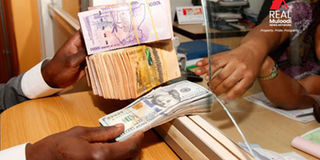Shilling loses against dollar for first time in over two years

The pick-up in corporate demand and some offshore demand for US Dollar led to the weakening of the shilling this week.
What you need to know:
A combination of both internal and external factors fueling the depreciation of the shilling against the dollar, among which include increase in corporate demand for dollars and strengthening of the dollar
The shilling has between April 2022 to date, depreciated against the dollar by 3 percent, according to Bank of Uganda.
This is the first time in over two years that the shilling is losing ground against the dollar.
Speaking in an interview early this week, Dr Adam Mugume, the Bank of Uganda director of research, said, a combination of both internal and external factors fueling the depreciation of the shilling against the dollar, among which include increase in corporate demand for dollars and strengthening of the dollar.
“The increase in global commodity prices means that payment for oil and other essential commodities require more dollars. Put differently, the demand for dollars to pay for essential raw materials, most of which are quoted in dollars, has gone up,” he said, noting that Bank of Uganda will continue to monitor the market to ensure stability. Ms Catherine Kijjagulwe, the Absa head of trading, said the shilling had continued to exhibit volatility, opening Wednesday at Shs3,660 per dollar, before closing at Shs3650.
This, she said, was driven by continued demand, prompting two Central Bank interventions on Wednesday, which relaxed the southward movement yesterday. By yesterday, according to Bank of Uganda, the shilling had marginally gained closing at Shs3,643.13 against the dollar.
Money markets were liquid on Wednesday with overnight yields at averages of 6.740 percent. Bank of Uganda held a Shs400b two-year and 10-year Treasury Bond auctions and yields cleared at averages of 9.9 percent and 13.75 percent respectively.
In the Regional Economic Outlook for Sub Saharan African published in April, International Monetary Fund, said the central banks should manage exchange rate adjustment on the back of monetary tightening in the US, which could rise risk premiums exacerbated by the conflict between Russia and Ukraine.




